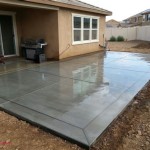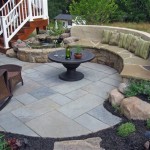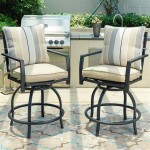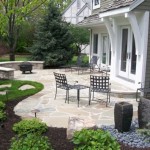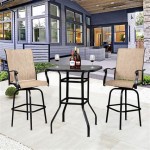```html
Beautiful Patio Ideas
A patio functions as an extension of the home, offering a space for relaxation, entertainment, and connection with the outdoors. Transforming a patio into a beautiful and functional area requires careful planning and consideration of various design elements. This article explores several patio ideas that can enhance the aesthetic appeal and usability of outdoor living spaces.
Design Considerations for Patios
Before embarking on a patio design project, it is essential to consider several factors that will influence the final outcome. These factors include the available space, the intended use of the patio, the architectural style of the house, and the climate.
The size of the patio will dictate the types of furniture and features that can be accommodated. A small patio may be best suited for a cozy seating area with a small table, while a larger patio can accommodate a dining table, lounge chairs, and even an outdoor kitchen.
The intended use of the patio will also influence the design. A patio intended primarily for relaxation may benefit from comfortable seating, shade structures, and water features. A patio intended for entertaining may require a larger space, ample seating, and an outdoor kitchen or bar.
The architectural style of the house should be considered to ensure that the patio complements the overall aesthetic. A modern house may benefit from a minimalist patio design with clean lines and contemporary materials, while a traditional house may benefit from a more classic patio design with natural materials and ornate details.
The climate should also be considered when selecting materials and features for the patio. In hot climates, shade structures, such as pergolas or umbrellas, are essential for providing relief from the sun. In cold climates, outdoor heaters or fire pits can extend the patio season.
Exploring Patio Flooring Options
The flooring of a patio significantly impacts its overall aesthetic and functionality. Several materials are available, each with its own advantages and disadvantages. Common patio flooring options include concrete, pavers, stone, and wood.
Concrete is a durable and versatile material that can be stained, stamped, or textured to create a variety of looks. It is a relatively inexpensive option and is easy to maintain. However, concrete can be prone to cracking and can become hot in direct sunlight.
Pavers are individual stones or bricks that are set in a pattern to create a cohesive surface. They are available in a wide range of colors, shapes, and sizes, allowing for a high degree of customization. Pavers are generally more expensive than concrete but are more resistant to cracking and can be easier to repair.
Stone is a natural material that adds a touch of elegance and sophistication to any patio. It is available in a variety of types, including flagstone, slate, and travertine. Stone is a durable and long-lasting option, but it can be expensive and require professional installation.
Wood is a warm and inviting material that creates a comfortable and relaxing atmosphere. It is a popular choice for decks and patios, but it requires regular maintenance to prevent rot and decay. Wood can be stained or painted to match the aesthetic of the house.
Integrating Landscaping and Greenery
Landscaping and greenery can transform a patio into a lush and inviting oasis. Plants can add color, texture, and fragrance to the space, creating a more relaxing and enjoyable atmosphere. Several types of plants are suitable for patios, including flowers, shrubs, trees, and vines.
Flowers can add pops of color and visual interest to the patio. Consider planting a variety of flowers with different colors and bloom times to ensure that the patio remains vibrant throughout the season. Popular patio flowers include petunias, geraniums, and impatiens.
Shrubs can provide structure and privacy to the patio. They can be used to create hedges, borders, or focal points. Consider planting evergreen shrubs for year-round greenery. Popular patio shrubs include boxwood, azaleas, and hydrangeas.
Trees can provide shade and create a sense of enclosure on the patio. They can be planted in containers or directly in the ground. Consider planting trees with interesting foliage or flowers. Popular patio trees include Japanese maples, dogwoods, and crepe myrtles.
Vines can add vertical interest to the patio. They can be trained to grow on walls, fences, or pergolas. Consider planting vines with fragrant flowers or edible fruits. Popular patio vines include clematis, wisteria, and grapevines.
Container gardening is a versatile way to incorporate plants into a patio design. Plants can be grown in pots, planters, or hanging baskets, allowing for easy relocation and customization. Container gardening is particularly useful for small patios or for areas where planting in the ground is not possible.
Incorporating Water Features for Tranquility
Water features can add a sense of tranquility and relaxation to a patio. The sound of running water can be soothing and can help to mask unwanted noise. Several types of water features are suitable for patios, including fountains, ponds, and waterfalls.
Fountains are a popular choice for patios because they are relatively easy to install and maintain. They are available in a wide range of styles and sizes, from small tabletop fountains to large freestanding fountains. Fountains can be made from a variety of materials, including stone, ceramic, and metal.
Ponds can add a natural and inviting element to a patio. They can be stocked with fish and aquatic plants, creating a miniature ecosystem. Ponds require more maintenance than fountains, but they can provide a greater sense of connection with nature.
Waterfalls can create a dramatic and eye-catching focal point on a patio. They can be built from stone, concrete, or other materials. Waterfalls require professional installation and may require more maintenance than fountains or ponds.
Lighting for Ambiance and Safety
Lighting is essential for creating a welcoming and functional patio space, especially during the evening hours. Proper lighting can enhance the ambiance, improve safety, and extend the usability of the patio. Several types of lighting are suitable for patios, including string lights, path lights, and spotlights.
String lights are a popular choice for creating a festive and inviting atmosphere. They can be strung across trees, fences, or pergolas, creating a soft and ambient glow. String lights are available in a variety of styles and colors, including incandescent, LED, and solar-powered.
Path lights are used to illuminate walkways and pathways on the patio, improving safety and visibility. They can be installed along garden beds, steps, or other areas where people may walk. Path lights are available in a variety of styles and materials, including solar-powered and low-voltage options.
Spotlights can be used to highlight specific features of the patio, such as trees, sculptures, or water features. They can be adjusted to create different lighting effects, such as accent lighting or uplighting. Spotlights are available in a variety of styles and wattages.
Furniture Selection for Comfort and Style
Patio furniture should be comfortable, durable, and stylish. It should be chosen to complement the overall design of the patio and to meet the needs of the users. Several types of furniture are suitable for patios, including chairs, tables, and sofas.
Chairs are an essential element of any patio seating area. They should be comfortable and supportive, allowing users to relax and enjoy the outdoors. Patio chairs are available in a variety of styles and materials, including Adirondack chairs, rocking chairs, and lounge chairs.
Tables provide a surface for eating, drinking, and socializing on the patio. They should be chosen to match the size and style of the seating area. Patio tables are available in a variety of shapes and sizes, including coffee tables, dining tables, and side tables.
Sofas provide a comfortable and spacious seating option for larger patios. They are ideal for relaxing and entertaining guests. Patio sofas are available in a variety of styles and materials, including wicker, metal, and wood.
Consider furniture made from weather-resistant materials like teak, aluminum, or resin wicker to ensure longevity and minimize maintenance.
Shade Structures for Sun Protection
Providing shade on a patio is essential for creating a comfortable and usable space, especially during the hot summer months. Shade structures can protect users from the sun's harmful rays and can help to keep the patio cool and comfortable. Several types of shade structures are suitable for patios, including pergolas, umbrellas, and awnings.
Pergolas are open-roofed structures that provide partial shade. They can be constructed from wood, metal, or other materials. Pergolas can be covered with vines or fabric to provide additional shade. They offer a balance between sun exposure and protection.
Umbrellas are portable shade structures that can be easily moved around the patio as needed. They are available in a variety of sizes and styles, including cantilever umbrellas and market umbrellas. Umbrellas are a cost-effective and flexible shade solution.
Awnings are retractable shade structures that can be attached to the house or to a freestanding frame. They provide complete shade when extended and can be retracted when not needed. Awnings are a more permanent shade solution that can significantly increase the value of the home.
```
Planning For A Paver Patio Ideas And Inspiration Town Country Living

75 Patio Ideas You Ll Love November 2024 Houzz

60 Best Backyard Patio Ideas 2024

50 Stylish Small Patio Ideas Designer Patios Tips And Tricks

The Best Small Patio Ideas To Enjoy This Summer

Patio Design Ideas Backyard Garden Landscaping Designs Around

50 Best Patio Design Ideas For Outdoor And Backyard In 2024 Foyr

10 Captivating Patio Ideas For A Stunning Backyard

Images Of 20 Beautiful Patio Designs

9 Best Backyard Patio Ideas For Inspirations Deepnot Covered Patios
Related Posts


